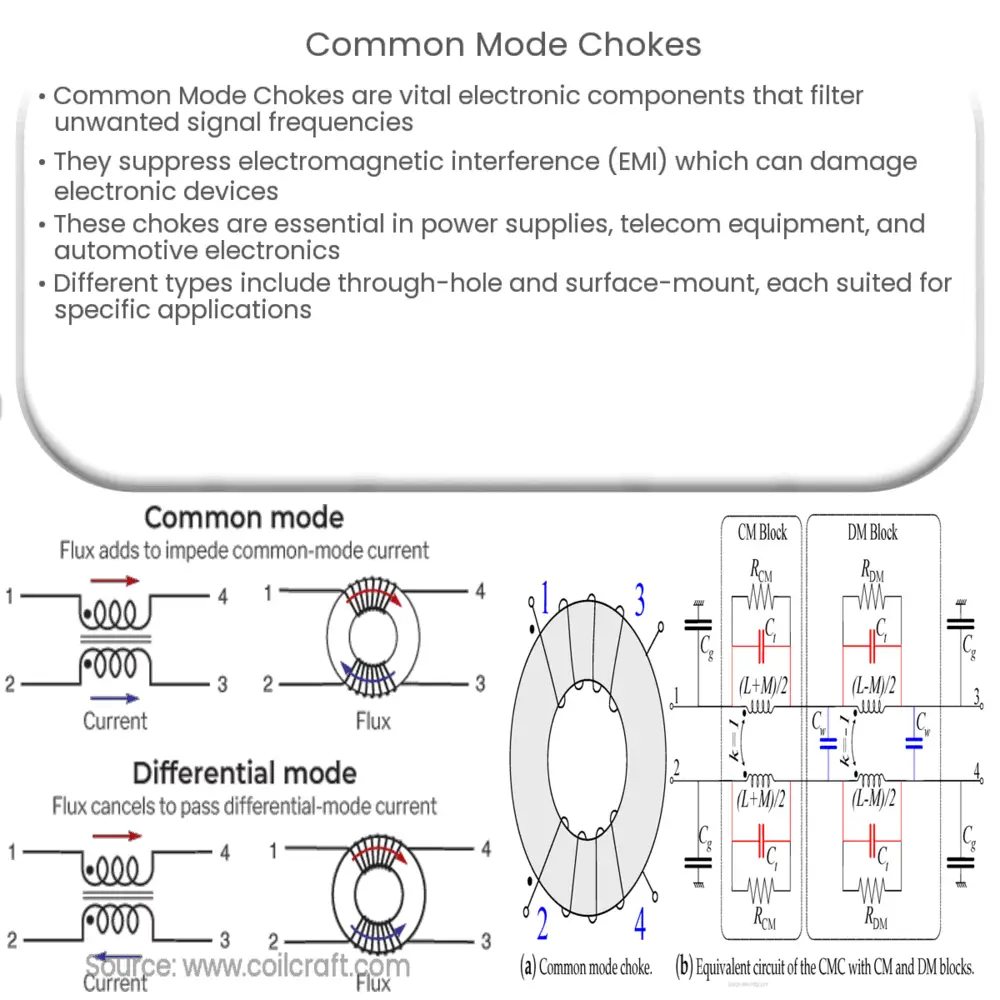Explore the role of Common Mode Chokes in electronics, their design, types, selection parameters, and their impact on system performance.

Introduction to Common Mode Chokes
A Common Mode Choke is a crucial electronic component commonly used to filter out unwanted signal frequencies in an electronic system. Essentially, it’s a device employed to block or ‘choke’ common mode noise while allowing differential signals to pass through.
Functionality and Design
The main function of a Common Mode Choke is to suppress electromagnetic interference (EMI), which can be generated internally or picked up externally by electronic devices. EMI can cause performance issues and potential damage if not appropriately managed, hence the necessity of components like the Common Mode Choke.
The Common Mode Choke is designed with two coil windings on a single magnetic core. This design allows for high impedance (resistance to electrical current) to common mode signals, effectively blocking or ‘choking’ them, while offering minimal impedance to differential signals.
Applications of Common Mode Chokes
- Common Mode Chokes are widely used in power supply units and cables to filter out EMI and radio frequency interference (RFI). This makes them integral components in many modern electronics.
- They also play a vital role in telecommunications equipment, mitigating EMI that can interfere with data transmission.
- Furthermore, in the automotive industry, Common Mode Chokes are used in electronic control units, navigation systems, and other on-board electronics.
The Different Types of Common Mode Chokes
- Through-hole Common Mode Chokes: These are designed for mounting via holes drilled in printed circuit boards (PCBs). They’re known for their durability and capability to withstand higher electrical currents.
- Surface-mount Common Mode Chokes: These are directly mounted onto the surface of PCBs. They’re popular for their small size and low cost, making them a suitable choice for compact, high-frequency applications.
How to Choose a Common Mode Choke
Several factors need consideration when choosing a Common Mode Choke. Among these are the intended application, required impedance, current rating, and physical size. Understanding these parameters ensures the choke selected will perform effectively and reliably in the intended circuit.
Key Parameters in Selecting a Common Mode Choke
Intended Application: The use-case scenario plays a pivotal role in determining the right kind of Common Mode Choke. For instance, automotive electronics may require chokes that can withstand harsher conditions and higher currents than those used in small household appliances.
Impedance: A choke’s impedance level directly influences its effectiveness in suppressing EMI. A higher impedance level generally results in better EMI suppression.
Current Rating: The choke should be capable of handling the current that will flow through it in the circuit. An underrated choke could lead to overheating and potential failure.
Physical Size: The available space on the PCB or within the device will dictate the physical size of the choke. Surface-mount chokes are typically smaller and more suitable for compact applications, while through-hole chokes may be larger but can handle higher currents.
Common Mode Chokes and Circuit Protection
Besides mitigating EMI, Common Mode Chokes also provide a measure of circuit protection. By suppressing unwanted high-frequency noise, these chokes can prevent potential damage to sensitive electronic components within a device.
Impact on System Performance
The use of Common Mode Chokes contributes significantly to the overall performance of an electronic system. A system with well-managed EMI and RFI will function more reliably, with less risk of data loss or corruption, and fewer disturbances to its operation.
Conclusion
In conclusion, Common Mode Chokes are an integral part of modern electronics, playing a crucial role in maintaining the integrity and reliability of electronic devices. By suppressing EMI and RFI, they help ensure stable performance and prevent potential damage to sensitive components. Understanding the critical parameters of intended application, impedance, current rating, and physical size helps in selecting the right choke for a particular circuit. Thus, they are an essential consideration in the design and operation of any electronic system.

